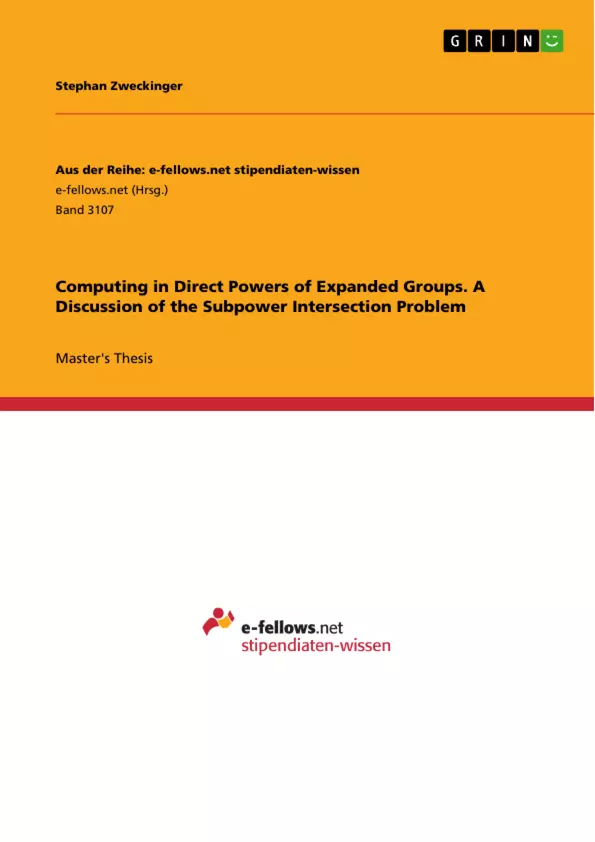In this thesis, expanded groups and the Subpower Intersection Problem for direct powers of groups will be discussed and then implemented in GAP.
The first chapter is an introduction to universal algebra and GAP. Algebraic structures, especially groups, expanded groups, direct powers and some conceptsare defined as belonging to algebraic structures. Then an introduction to the programming language GAP, which was developed for computations in algebra, is given and GAP is used for proving a theorem about polynomial functions on groups of order 8.
In the second chapter the theory of expanded groups, especially how to find the universe of an expanded group given by generators is explored. After that a data structure for computing with expanded groups in GAP and use this data structure for proving that not every normal subgroup of an expanded group is also an ideal and for counting the binary polynomials of a concrete expanded group is develeoped.
The last chapter is about the Subpower Intersection Problem for direct powers of groups. First, the concept of strong generators for direct powers of groups is dintroduced and then it is discused how to find strong generators of the intersection of direct powers of groups. Finally, the algorithms for solving the problem in GAP and discuss compatible functions asan application of the Subpower Intersection Problem are implemented.
Inhaltsverzeichnis (Table of Contents)
- Universal Algebra and GAP
- Algebras
- GAP
- An Example Combining Theory and GAP
- Expanded Groups
- Generators of Expanded Groups
- Functions with Finite Degree
- Direct Powers and Ideals of Expanded Groups
- A Data Structure for Expanded Groups in GAP
- Computing in Expanded Groups with GAP
- Subpower Intersection Problem
- Strong Generators of Groups
- The Subpower Intersection Problem
- Implementation in GAP
- Counting Compatible Functions
Zielsetzung und Themenschwerpunkte (Objectives and Key Themes)
This thesis explores the concept of expanded groups and the Subpower Intersection Problem for direct powers of groups. It aims to implement these concepts in the GAP programming language, providing practical tools for algebraic computations.
- Exploring the theory of expanded groups, including methods for finding their universes and identifying their ideals.
- Developing a data structure within GAP for efficient computation with expanded groups.
- Investigating the Subpower Intersection Problem, specifically focusing on finding strong generators for intersections of direct powers of groups.
- Implementing algorithms for solving the Subpower Intersection Problem in GAP.
- Demonstrating applications of the Subpower Intersection Problem, such as counting compatible functions.
Zusammenfassung der Kapitel (Chapter Summaries)
- Chapter 1: This chapter introduces the fundamental concepts of universal algebra, including definitions of algebraic structures, groups, expanded groups, and direct powers. It also provides an overview of the GAP programming language, highlighting its capabilities for algebraic computations. The chapter concludes with an example demonstrating the integration of theoretical concepts with GAP programming.
- Chapter 2: This chapter delves into the theory of expanded groups. It examines methods for finding the universe of an expanded group given its generators. The chapter then develops a dedicated data structure within GAP for working with expanded groups. This data structure is used to demonstrate that not every normal subgroup of an expanded group is also an ideal and to count the number of binary polynomials for a specific expanded group.
- Chapter 3: This chapter focuses on the Subpower Intersection Problem. It introduces the concept of strong generators for direct powers of groups and explores methods for finding such generators for intersections of these powers. Algorithms for solving the Subpower Intersection Problem are implemented in GAP. The chapter concludes with a discussion of compatible functions as an application of the Subpower Intersection Problem.
Schlüsselwörter (Keywords)
This work centers around the concepts of expanded groups, direct powers of groups, Subpower Intersection Problem, strong generators, and GAP programming. It utilizes theoretical frameworks of universal algebra and employs practical implementation techniques in GAP to address computational challenges in these algebraic structures.
- Arbeit zitieren
- Stephan Zweckinger (Autor:in), 2013, Computing in Direct Powers of Expanded Groups. A Discussion of the Subpower Intersection Problem, München, GRIN Verlag, https://www.grin.com/document/469947



